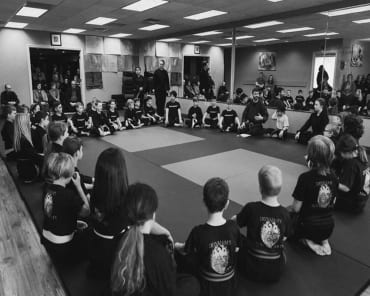Today we will continue our discussion of The Ten Considerations of Combat. We have discussed Environment, Range, Positions, and Maneuvers. Here we will discuss Targets, and Natural Weapons.
5. Targets
Targets determine techniques. It can be no other way.
The student must be able to both identify available targets, and determine the appropriate techniques and weapons to use against those targets.
Understanding the opponent's position allows the student to identify the available targets exposed by that position. Are his arms too low to effectively defend his head? Is his body bladed, or is he facing the student square, exposing his solar plexus at a ninety degree angle to the student? These questions are important and must be answered by the student within fractions of a second.
Once the targets are identified, the student must be able to execute the appropriate techniques. The natural contours of the human body, as well as the size and density of the chosen target are some of the aspects which determine the appropriate weapon. It would be inappropriate to use a finger thrust technique to the opponents jaw, however, that same technique might be appropriate to the eye. A front thrust kick may be appropriate for a strike to the opponent's bladder, but not generally to the opponent's solar plexus.
The availability of targets fluctuates constantly with changes in the opponent's position. Identifying targets, selecting the appropriate weapons, and launching the appropriate techniques must all occur with immediacy, something which comes with experience and consistent practice.
6. Natural Weapons
Natural Weapons are the tools with which the student is able to execute his offensive technique.
In this case, the deliniation of these as "natural" weapons means that they are those parts of the student's body itself which can be used in an aggressive manner. Typically this is thought of as arms and legs, hands and feet, but in practice there are other natural weapons which can also be applied to the situation.
Every part of the human body can be used either as a striking surface, or as a fulcrum against which leverage can be applied to injure or maim the opponent. The head and forearms can be used as striking surfaces, or the neck and shoulders as fulcrum points.
Perhaps the most important natural weapon is the mind. Learning that the mind can be used as a weapon is a key step in the student's instruction. It can be used to escalate or de-escalate a situation. It can be used to dissuade an attacker from his intended use of aggression, or infuriate him into acting irrationally. It can be used to disguise the student's intentions, techniques, and direction.
Understanding the use of natural weapons is key to self defense.
Drills -
Beginner: Students A and B face each other in a fighting stance. Student A calls out one target and a weapon he could use to strike it on Student B's body, then performs that basic making sure to hit his target with a good basic strike. Student B then chooses a different target on Student A, calls it out and names his basic and then executes a controlled strike. Alternate until one student or the other can not think of a new target. Begin again.
Intermediate: Students A and B practice Three Hit Kenpo with selected categories of targets and weapons. Upper body, closed hand strikes, front of the body, kicks and leg strikes, etc.
Advanced: Students practice Offensive Defense. While sparring, each student identifies which targets he will be hitting in combination, and which weapons he will use. Combinations must be two or more targets and include both arm and leg strikes.






